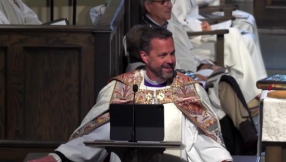
The writer of the Letter to the Hebrews reminds Christians that they are surrounded by a great "cloud of witnesses." (NRSV) That "cloud" has continued to grow in size since then. In this monthly column we will be thinking about some of the people and events, over the past 2000 years, that have helped make up this "cloud." People and events that have helped build the community of the Christian church as it exists today.
One of the most famous of London's many statues stands in Piccadilly Circus. Atop the monument a naked, winged, youth is dramatically poised – bow in hand – in the act of firing arrows down into the crowds and traffic of this busy spot in central London.
Ask Londoners, passing tourists, and millions of people worldwide who is represented by the statue and almost all will reply: "It's Eros, ancient Greek god of romantic love." The statue is now internationally famous and even appears on the masthead of the Evening Standard in print and online.
Erected in 1893, it became such a well-known landmark that it was removed for safety during the First World War (going back up in 1919); then removed again during the construction of Piccadilly Circus underground station in the 1920s; and removed for a third time, to protect it during the Second World War.
Since then, it has been a permanent feature, except for a brief time in the 1980s when it was removed for restoration. More recently, the statue's bow was replaced in 2012, after being damaged by a tourist, and – when this too was damaged – it was replaced again, in 2022, when the new bow was made from aluminium. However, there is more to this statue than meets the eye or is represented in numerous cartoons and representations.
The problems with "Eros"
Firstly, there is the matter of the identity of the winged archer. It is not "Eros." It must be admitted that there is a bit of confusion about this, but what is clear is that nobody at the time of its erection named it as the god of romantic love.
Then, during the First World War, it began to be increasingly referred to as "Eros" and from that point onwards the "identity" was fixed. However, in 1921, a book about its sculptor, Sir Alfred Gilbert, claimed he had described it as "reflective and mature love, as opposed to Eros or Cupid, the frivolous tyrant."
This has caused a lot of people to assume that, rather than Eros, the statue represents Eros' brother, Anteros, the ancient Greek god of reflective love. This may be consistent with a statement made by Gilbert, in 1903, when he stated that his aim was to represent "blindfolded Love sending forth indiscriminately, yet with purpose, his missile of kindness."
But that could mean that the statue may simply represent a personification of love showered down (represented by arrows) on people. No Eros. No Anteros. Spoiler alert: the statue is not blindfolded, so the description is a bit confusing!
Secondly, the official name of the monument is not "Eros" and never has been. It is actually called the "Shaftesbury Memorial Fountain," or the "Shaftesbury Monument." The latter name is now more appropriate since there is no longer any flowing water at the site. This is definitely not how it is titled on tea-towels, T-shirts, cartoons, or Valentine's Day cards.
In that same 1903 statement about "blindfolded Love," Gilbert had earlier explained that he had "been actuated in its design by a desire to symbolize the work of Lord Shaftesbury." During the memorial's unveiling in 1893, The Times newspaper described the fountain there as "'illustrative of Christian charity", the idea being of love and kindness freely bestowed on all. This was decades before anyone described it as "Eros." That is why the statue is sometimes described as the "Angel of Christian Charity," although you won't find that on many tea-towels or T-shirts. Perhaps one should!
Far from being a monument of romantic or sexual love, the statue that now dominates Piccadilly Circus was erected in 1893 as a memorial to the Christian philanthropist Lord Shaftesbury.
How a mis-named "statue of Romantic Love" is actually a reminder of an extraordinary Christian reformer
Anthony Ashley-Cooper, 7th Earl of Shaftesbury (1801–1885) was one of the most effective social and industrial reformers of the nineteenth century. He became Lord Ashley when his father succeeded to the family earldom in 1811 and entered Parliament in 1826 as MP for Woodstock.
This was one of the so-called "pocket boroughs" which, before the 1832 Reform Act, was "in the pocket" of a wealthy landowner who could gift it to whomever they pleased. In this case the "pocket" belonged to his uncle, the Duke of Marlborough. On the death of his father, in 1851, he entered the House of Lords as Earl of Shaftesbury.
Like all people, he was complex, and his actions sometimes reflected his class and time. In 1832, he attacked the Reform Bill which was extending the right to vote beyond a tiny percentage of the electorate; he was accused of focusing more on the conditions faced by industrial workers than on the conditions experienced by the rural labourers on the Shaftesbury estates; and he shared with many others of his contemporaries deep suspicions regarding Catholic faith.
However, while this reminds us that all human "heroes" are imperfect, there is simply no denying the massive positive impact he had on his society and this was firmly rooted in his evangelical Christian faith.
He favoured the political emancipation of Roman Catholics and supported the repeal of the Corn Laws (import duties on grain), in 1846. These were actions which broke out of the narrow outlook of many of his elite contemporaries. It revealed a willingness to engage with contested and complex issues in a way which promoted social justice.
Shaftesbury became a "lunacy commissioner" in 1828, at a time when the mentally ill were both brutally marginalised and those in institutions were often treated as a "peep show" to entertain others. He drove forward the passage of the Lunacy Act of 1845, which was the first British legal statute to treat the severely mentally ill as "persons of unsound mind," rather than as outcasts.
He was a long-time supporter of factory reform. In the expanding factory system of the industrial revolution, hours, conditions, and pay were shockingly poor for vast numbers of workers. After 1833, Shaftesbury became leader of the factory reform movement in parliament. The law for shortening the working day in textile mills – the Ten Hours Act of 1847 – is popularly known as Lord Ashley's Act.
The Mines Act of 1842, which he promoted, banned all women and girls, and all boys under the age of 10, from underground work in coal mines. Prior to this act, children as young as four or five could be found in mines. Acting as "trappers," opening and shutting doors, they would sit for hours in total darkness. As one confided to a reforming commissioner, "sometimes I am frightened of the dark."
Pregnant women worked far into their pregnancies. One explained that "the belt and chain [belt round the waist, chain between the legs, to haul a heavy container of coal] is worse when we are in the family way." And women and girls often experienced appalling sexual abuse underground. The Mines Act aimed to put a stop to all this.
He fought against the practice of chimney sweeps sending children up chimneys. Children who spent their life in soot often suffered from skin cancers and were sometimes trapped and died in the narrow confines of a domestic chimney.
As a member of the General Board of Health (1848–54) he argued for state sponsorship of low-cost housing for industrial cities. Urban centres, which had massively expanded during the industrial revolution, were notorious for the poor quality, unhealthy, and overcrowded housing that had sprung up to accommodate industrial workers and their families.
For thirty-nine years he was president of the so-called Ragged Schools Union. This made it possible for 300,000 destitute children to receive some free education.
He served as president of the British and Foreign Bible Society, which made vernacular translations of the Scriptures available to peoples of all ethnic groups, at a price they could afford. It helped put the Bible into the hands of vast numbers of people who, otherwise, would not have been able to afford them.
He supported the foundation of large numbers of Young Men's Christian Associations and Working Men's Institutes. These provided safe spaces for relaxation and education.
In addition, he financially supported a number of Nonconformist missionary societies, as well as those belonging to the Church of England, which showed a generosity of spirit which looked beyond denominational boundaries.
The impact of Lord Shaftesbury
Shaftesbury was something of an obsessive. Florence Nightingale (rather an obsessive herself) apparently wryly observed that, had he not been so committed to reform of the lunatic asylum system, he would have been in one himself. But his achievements were massive. And perhaps it took a special kind of obsessiveness to drive forward so many reforms, on so many fronts.
What is undeniable is that his impact was huge and lasting. When he died, vast numbers of ordinary people took to the streets of London to pay their respects as his coffin went past. That is an extraordinary testimony to the man and his work.
Shaftesbury would have explained that his reforming work was the logical outcome of his deep Christian faith. His life and his achievements provide an extraordinary testimony to the reality of that faith and how it inspired him to action on behalf of others. That is an enduring legacy. Next time you see that statue in Piccadilly Circus, think of the reality behind it of a life of Christian service, rather than the popular legend that has obscured its meaning.
Martyn Whittock is a historian and a Licensed Lay Minister in the Church of England. The author, or co-author, of fifty-six books, his work covers a wide range of historical and theological themes. In addition, as a commentator and columnist, he has written for several print and online news platforms and been interviewed on TV and radio news and discussion programmes exploring the interaction of faith and politics. His recent books include: Daughters of Eve (2021), Jesus the Unauthorized Biography (2021), The End Times, Again? (2021), The Story of the Cross (2021), and Apocalyptic Politics (2022). His latest book, American Vikings: How the Norse Sailed into the Lands and Imaginations of America (2023), examines evidence for Norse exploration (including by the first Christians to reach that continent) of North America and its impact on culture and politics there.













